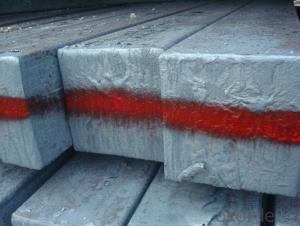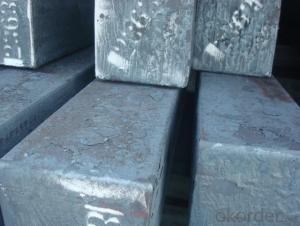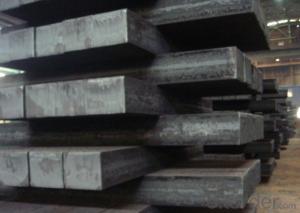Steel Billet Hot Rolled Q275 in Amazing Good Price
- Loading Port:
- Tianjin
- Payment Terms:
- TT OR LC
- Min Order Qty:
- 1000 m.t.
- Supply Capability:
- 50000 m.t./month
OKorder Service Pledge
OKorder Financial Service
You Might Also Like
1.Structure of Steel Billet
Steel billet(ingot) by cogging or breakdown of semi-finished products, is the raw material of all kinds of steel mill. Billet section of square, round, flat, rectangular and abnormity of several kinds of, mainly related to the shape of rolled products.
2.Main Features of Steel Billet
Rectangular billet continuous casting billet and mainly general carbon steel, low carbon low silicon cold-rolled material, high quality carbon structural steel, high strength low alloy steel, special steel, etc.
The billet is mainly divided into two kinds from the shape:
Slab: cross section width and height of the ratio of the larger, mainly used for rolling plate.
Billet: equal cross section width and height, or a huge difference, mainly used for rolling steel, wire rod. ,
Steel billets have distinct characteristics as compared with already furnished steel bars and products. Billets have a specific grain structure, which enables the metal to be processed more intricately. Steel billets are also known for their malleability and ductility, especially when exposed to varying temperatures during shaping and molding.
3.Steel Billet Images


4. Steel Billet Specification
Hot rolled billet steel
Size: 50x50mm-180x180mm
Steel Grade: 3SP, 5SP,Q195,Q235,Q255,Q275 Length:3m-12m
MOQ: 1000MT/size
Payment term: TT or LC
Packing: in bulk , bundle
Shipment: by container , bulk vessel
Packaging Details: bundles with steel strips or as customers's requirements
Delivery time: 15-30 days after the deposit
Loading port:Tianjin, or other port China
Origin :China
Inspection:Third party inspection before loading.
5.FAQ
We have organized several common questions for our clients,may help you sincerely:
1) How about your company?
A world class manufacturer & supplier of castings forging in carbon steel and alloy steel,is one of the large-scale professional investment casting production bases in China,consisting of both casting foundry forging and machining factory. Annually more than 8000 tons Precision casting and forging parts are exported to markets in Europe,America and Japan. OEM casting and forging service available according to customer’s requirements.
2)If there’s something wrong with the quality of the products, how do we return the goods?
A: We promise you the quality will be the same as the samples you confirmed. If there’s something wrong with the quality of the products, please send back sample from the shipment goods to us and let us know the quantity, then we will investigate in our work shop. If it is our problem, we will offer you discount or replacements for free.
- Q: How do steel billets contribute to the environmental sector?
- There are several ways in which steel billets contribute to the environmental sector. Firstly, the production of steel billets often involves the recycling of scrap metal, which helps decrease the demand for raw materials and conserve natural resources. This process also reduces the energy needed for steel production, resulting in lower greenhouse gas emissions and a smaller carbon footprint. Moreover, steel billets find extensive use in construction projects, including the development of infrastructure and renewable energy installations. Steel is an incredibly durable material that can withstand harsh weather conditions and has a long lifespan. By utilizing steel billets in construction, we can create structures that require minimal maintenance and repair, reducing the necessity for frequent replacements and conserving additional resources. Furthermore, steel billets play a crucial role in the manufacturing of environmentally friendly products. Steel is a crucial component in the production of electric vehicles, wind turbines, and solar panels. These clean energy solutions aid in reducing our dependence on fossil fuels and decreasing harmful emissions, thus contributing to a cleaner and greener environment. Additionally, steel billets can be recycled once again at the end of their lifespan, further diminishing waste and minimizing the environmental impact. Recycling steel is an extremely efficient process that necessitates less energy and generates fewer emissions compared to the production of new steel from raw materials. In conclusion, steel billets contribute to the environmental sector through their recycling capabilities, durability in construction, and their role in the manufacturing of eco-friendly products. By incorporating steel billets into various industries, we can promote sustainability, conserve resources, and diminish our environmental footprint.
- Q: Can steel billets be used in the production of energy-efficient appliances?
- Certainly, energy-efficient appliances can make use of steel billets. Steel, being a versatile material renowned for its strength and durability, is extensively employed in appliance manufacturing. These appliances are designed to minimize energy consumption and greenhouse gas emissions by employing less energy while performing their designated tasks. When it comes to energy-efficient appliances, steel billets can be processed and transformed into numerous components, including outer shells, structural supports, and internal parts. The incorporation of steel ensures the longevity and dependability of these appliances, thereby enhancing their overall energy efficiency. Moreover, steel is highly recyclable, allowing it to be repurposed or reused for other applications once an appliance reaches the end of its lifecycle. Steel recycling aids in energy conservation and waste reduction, further bolstering the pursuit of energy efficiency. To summarize, the utilization of steel billets is indeed feasible in the production of energy-efficient appliances. The exceptional properties of steel, namely its strength, durability, and recyclability, make it an ideal choice for manufacturing appliances that promote a more sustainable future.
- Q: Billet heating furnace billet temperature reached, steel will be adhesion
- There are a lot of billet heating furnace manufacturers, not just look at the price and go blind choice, billet heating furnace selection properly, will directly affect the day after work is carried out properly, choose cost-effective equipment is the first choice for users, recommended to look at the video consultation.
- Q: Can steel billets be used in the production of agricultural equipment?
- Steel billets have the potential to be utilized in the manufacturing process of agricultural equipment. These billets are essentially unfinished products that are typically formed through a continuous casting method. They can undergo further processing to take on various shapes and sizes, which makes them suitable for the production of agricultural machinery like plows, cultivators, harrows, seeders, and other similar farm equipment. The utilization of steel billets in agricultural machinery brings about numerous benefits. Steel is renowned for its robustness, longevity, and resistance to deterioration, making it ideal for heavy-duty applications within the agricultural sector. Moreover, steel is capable of withstanding harsh environmental conditions, ensuring that the machinery remains dependable and functional even in demanding farming environments. Furthermore, steel can be easily shaped and fabricated into different forms, allowing for the customization of agricultural equipment to meet specific requirements. Overall, incorporating steel billets in the manufacturing process of agricultural equipment enhances the efficiency, productivity, and longevity of farming operations.
- Q: How do steel billet prices fluctuate in the market?
- Steel billet prices fluctuate in the market due to a variety of factors. One of the key factors is the demand and supply dynamics of the steel industry. When there is high demand for steel billets, prices tend to rise as suppliers have more leverage to set higher prices. Conversely, when demand is low, prices may decrease as suppliers compete for a smaller pool of buyers. Another important factor influencing steel billet prices is the cost of raw materials. Steel is primarily made from iron ore, coal, and scrap metal, and any fluctuations in the prices of these raw materials can directly impact the cost of producing steel billets. For example, if there is a shortage of iron ore, the price of steel billets may increase due to higher production costs. Additionally, market conditions and economic factors can also affect steel billet prices. Factors such as inflation, interest rates, and currency exchange rates can impact the overall cost of production and transportation, which in turn may influence the prices of steel billets. Furthermore, geopolitical events and trade policies can also play a role in price fluctuations. Tariffs, trade disputes, or changes in import/export regulations can disrupt the supply chain and impact the prices of steel billets. Overall, steel billet prices are subject to a complex interplay of factors, including demand and supply dynamics, raw material costs, market conditions, and geopolitical events. Traders, manufacturers, and investors closely monitor these factors to anticipate and respond to price fluctuations in the steel billet market.
- Q: How are steel billets used in the manufacturing of fasteners?
- Steel billets are used in the manufacturing of fasteners as they serve as the raw material for creating a variety of fastener types, including screws, bolts, and nuts. These billets are heated and then forged or rolled into the desired shape and size, forming the base of the fastener. The high strength and durability of steel make it an ideal material for fasteners, ensuring secure and reliable connections in various applications.
- Q: What is the role of steel billets in the construction of railway stations?
- Steel billets are essential in constructing railway stations, serving as semi-finished steel products that are typically rectangular or square in shape. They function as raw materials for various construction purposes. Within the realm of railway stations, steel billets are primarily utilized to fabricate structural components like beams, columns, and trusses. These components provide the necessary strength and stability to support the weight of the station building, platforms, and any associated structures. A key advantage of employing steel billets in railway station construction lies in their high strength-to-weight ratio. Steel is widely recognized for its exceptional strength, making it an ideal material for supporting heavy loads. By incorporating steel billets, engineers can design and construct railway stations capable of enduring the constant traffic and heavy footfall characteristic of these public spaces. Furthermore, steel billets offer exceptional durability, corrosion resistance, and fire resistance, all of which are vital factors in ensuring the long-term safety and structural integrity of railway stations. These properties establish steel billets as a reliable and cost-effective choice for construction projects prioritizing safety and longevity. Moreover, steel billets can be easily shaped and fabricated into various sizes and dimensions, allowing for flexibility in design and construction. This versatility enables architects and engineers to create aesthetically appealing and functional railway station structures tailored to the specific project requirements. In summary, steel billets play a crucial role in railway station construction by providing the necessary strength, durability, and versatility required for the structural components supporting these vital transportation hubs. By utilizing steel billets, railway station construction projects can be completed efficiently, guaranteeing the safety and comfort of passengers for years to come.
- Q: How are steel billets used in the production of building facades?
- Steel billets are used in the production of building facades as they serve as the raw material for manufacturing different components such as beams, columns, and plates. These billets are hot-rolled or forged into specific shapes and sizes, which are then used to create the structural framework of the facade. Additionally, steel billets are also used to create decorative elements and cladding panels that enhance the aesthetic appeal of the building exterior.
- Q: How do steel billets contribute to the manufacturing of agricultural equipment?
- Steel billets are a crucial component in the manufacturing of agricultural equipment due to their versatility and durability. These billets, which are essentially semi-finished steel products, serve as the foundation for various agricultural machinery and equipment. Firstly, steel billets are used to create the main structural components of agricultural equipment such as tractors, harvesters, plows, and tillers. These components, such as the chassis, frame, and axles, require a strong and sturdy material to withstand the heavy loads and harsh conditions encountered in agricultural operations. Steel billets provide the necessary strength and resilience to ensure the equipment can withstand the rigors of farming. In addition to the structural components, steel billets are also used to manufacture smaller parts and mechanisms that are integral to the functioning of agricultural machinery. For example, gears, sprockets, shafts, and bearings are commonly made from steel billets. These parts are essential for transmitting power and facilitating the smooth operation of various agricultural equipment. Moreover, steel billets contribute to the longevity and reliability of agricultural equipment. The high strength and durability of steel ensure that the machinery can withstand the demanding agricultural environment, including exposure to moisture, dirt, and extreme temperatures. This durability reduces maintenance requirements and extends the lifespan of the equipment, resulting in cost savings for farmers. Furthermore, steel billets can be easily shaped and molded into complex designs, allowing manufacturers to create customized agricultural equipment tailored to specific farming needs. This flexibility in design enables the production of specialized machinery for various agricultural operations, such as planting, harvesting, irrigation, and livestock management. Overall, steel billets play a vital role in the manufacturing of agricultural equipment by providing the necessary strength, durability, and versatility required for the demanding conditions of modern farming. Their contribution ensures that farmers have access to reliable and efficient machinery, ultimately increasing productivity and supporting sustainable agricultural practices.
- Q: What are the different types of steel billets?
- There exists a variety of steel billets, each possessing its own distinct attributes and applications. Among them, the most commonly encountered types are: 1. Carbon Steel Billets: Constructed from iron and carbon, these billets are widely employed due to their exceptional strength and durability. Consequently, they find utility in numerous sectors, including construction, automotive, and machinery manufacturing. 2. Alloy Steel Billets: By incorporating diverse alloying elements such as chromium, nickel, or manganese into carbon steel, alloy steel billets exhibit improved properties such as enhanced strength, hardness, and resistance to corrosion. Thus, they are frequently employed in industries necessitating high-performance materials, such as aerospace, oil and gas, and power generation. 3. Stainless Steel Billets: These billets are manufactured with a high chromium content, resulting in superior resistance to corrosion and oxidation. They are typically employed in applications where hygiene, durability, and aesthetic appearance are of utmost importance, such as food processing, medical equipment, and architectural structures. 4. Tool Steel Billets: Engineered to possess remarkable hardness, wear resistance, and heat resistance, tool steel billets are widely utilized in the fabrication of cutting tools, molds, and dies for various industries, including automotive, manufacturing, and construction. 5. Electrical Steel Billets: Comprised of low carbon steel with unique magnetic properties, electrical steel billets find application in the production of electrical equipment, such as transformers, motors, and generators. Their significance lies in their ability to minimize energy loss and exhibit high magnetic permeability. 6. High-speed Steel Billets: These billets are alloyed with elements such as tungsten, molybdenum, and cobalt, which enable them to retain their hardness and strength under high temperature conditions. They are extensively employed in the manufacture of cutting tools necessary for high-speed cutting operations, including drills, milling cutters, and taps. These examples represent only a fraction of the diverse range of steel billets available. The selection of a particular steel billet hinges upon the specific requirements of the application, such as strength, durability, corrosion resistance, or specialized properties essential for specific industries.
Send your message to us
Steel Billet Hot Rolled Q275 in Amazing Good Price
- Loading Port:
- Tianjin
- Payment Terms:
- TT OR LC
- Min Order Qty:
- 1000 m.t.
- Supply Capability:
- 50000 m.t./month
OKorder Service Pledge
OKorder Financial Service
Similar products
Hot products
Hot Searches
Related keywords




























